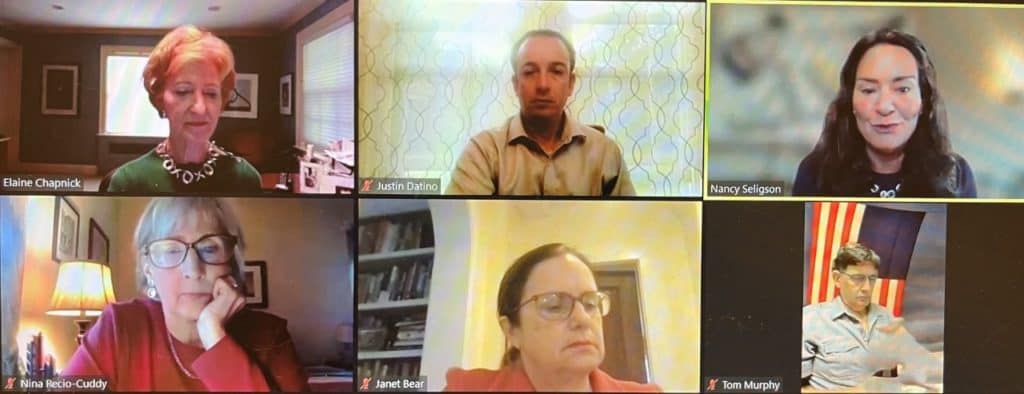
A Look at How Our Communities Are Dealing with the Unprecedented Damages
By Linnet Tse
Six weeks after Hurricane Ida pummeled the Sound Shore communities, local officials gathered on Zoom to give the Larchmont-Mamaroneck Local Summit audience an update on the damages wrought by Hurricane Ida and what lies ahead.
Town of Mamaroneck Supervisor Nancy Seligson, who is also Co-chair of Sustainable Westchester, a nonprofit consortium of Westchester County local governments that facilitates effective collaboration on sustainability initiatives, set the stage by reminding us why our communities were so prone to severe flooding from Ida.
She cited three reasons: 1) heavy development with minimal natural areas to absorb water; 2) an 80+ year-old stormwater system built to handle storms of a much smaller magnitude; and 3) our being located at the bottom of the drainage basins of the Sheldrake and Mamaroneck Rivers, resulting in all the excess rain and flooding from upstream flowing down to our communities.
Extensive Damage Concentrated in the Village of Mamaroneck
With 8 ½ inches of rain in less than 12 hours, our communities were hard hit by unprecedented levels of flooding and destruction, which led to President Biden declaring the region a disaster area eligible for Federal disaster funding.
While residential and commercial buildings in all three communities experienced flooding, the greatest damage was sustained by the Village of Mamaroneck (VoM), especially in the Columbus Park area, which is the confluence of the Sheldrake and Mamaroneck Rivers. VoM Mayor Tom Murphy described the harrowing evening of September 1 when streets and homes flooded with 10-12 feet of water. Numerous families and businesses lost everything, and a large number of residents are still displaced. Murphy estimates damages to VoM municipal property in excess of $12 million. The Mamaroneck Avenue fire station was devastated, four police cars were lost, and the Tompkins Avenue bridge was severely damaged.
According to Seligson, the Town sustained extensive road shoulder wash outs, curb and pavement damage, exposed sewer pipes, displaced cache basin castings and culvert and bridge damage. The Town is estimating damages well in excess of $1 million.
The Village of Larchmont (VoL) suffered minimal damage in comparison to its neighbors. VoL Administrator Justin Datino estimates damages to municipal property on the order of $350,000-$500,000, most of that sustained by the Larchmont Public Library, which had flooding on its lower level, and Town Hall.
All three municipalities will seek reimbursement from FEMA.
Herculean Clean-up and Recovery Efforts
Seligson, Murphy, and Datino gave a huge shout-out to the DPW, Sanitation and Highway Department workers from all three communities who worked for more than two weeks straight to clean up the bulk of the debris left in Ida’s wake. They also expressed appreciation for the County’s support, especially its assistance in finding shelter for the numerous displaced families.
Calling it “the most generous municipal act I’ve seen in my time in government,” Murphy thanked Cortlandt Town Supervisor Linda Puglisi for sending Cortlandt’s entire DPW team and equipment to assist the VoM for a week.
Quick action by Murphy, working with Senator Schumer’s office, resulted in FEMA (Federal Emergency Management Agency) and the Red Cross setting up their headquarters in the Village of Mamaroneck courthouse, thereby providing local residents easier access to these much-needed resources.
The panelists also cited the important role the Community Resource Center (CRC) and other local NFP organizations and volunteers played in the clean-up and recovery phases after Ida. According to Seligson, the silver lining was seeing the community come together to help one another.
While much of the clean-up has been completed, rebuilding will be a much slower process.
Looking Ahead . . . . What Can Be Done?
Although it’s unlikely that anything could have prevented some flooding with a storm as fierce as Ida, steps could be taken to lessen the damage. On a neighborhood level, Seligson urged residents to keep the cache basins in front of their homes clear of debris and leaf litter.
Seligson suggested the possibility of dredging the rivers to provide more carrying capacity for the water and improving some of the outdated drainage systems. She pointed out some water infrastructure funding is included in President Biden’s infrastructure proposal.
Murphy emphasized the importance of getting the US Army Corps of Engineers flood mitigation plan for the Mamaroneck and Sheldrake River Basin back on track. The study was completed in December 2017, and the $82MM project approved by Congress in fall of 2018. However, funding was denied during the Trump administration, forcing it to be put on hold. Murphy has been working very closely with Senator Schumer’s office since then to revive it.
The Local Summit thanks LMC Media for hosting this webinar. To learn more about The Local Summit visit: localsummitlm.org. To learn more about LMC Media visit: lmcmedia.org. Click here to watch the program on LMC Media Online. The next Local Summit program, “Navigating the COVID 19 Vaccine and the Effects on Our Community” will be held on Tuesday, November 9th, at 8 am.





